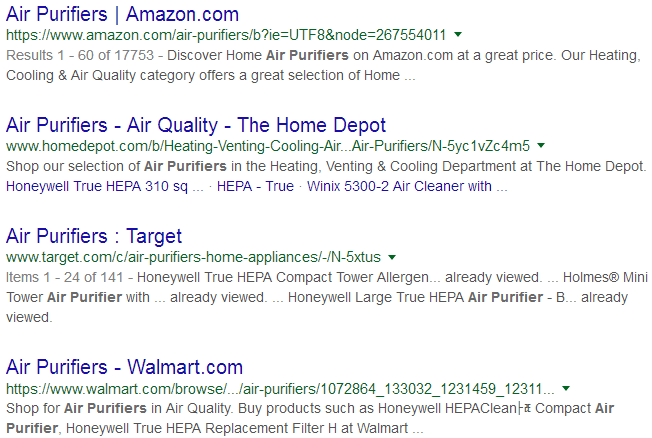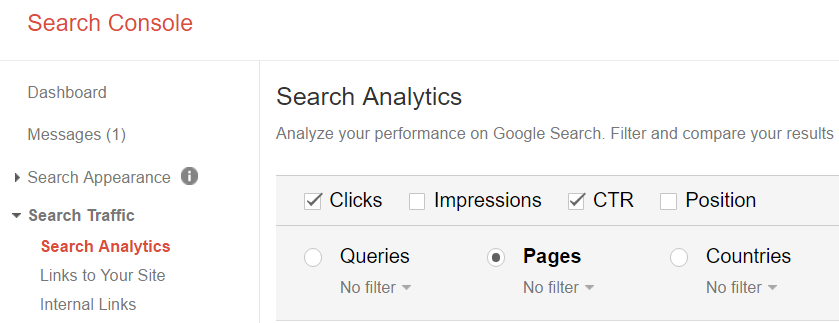[av_textblock size=” font_color=” color=”]
SEO Tactic #3: Treat Organic Search Snippets like Ads

Bland.
Boring.
Blah.
It is truly stunning how lifeless some organic search meta descriptions are. It’s as if some retailers don’t even care whether their description is enticing to a potential customer who’s sitting on their laptop, credit card at the ready, on the verge of making a purchase. Why wouldn’t they put a teeny bit of effort into making their product actually sound attractive? I don’t know! It’s baffling.
That’s not totally true; I do know that it’s difficult to write individualized search snippets if you have a large catalog of products, which is definitely the case for some of the examples I’m going to use below. So I’d like to preemptively apologize to these mega-retailers for pointing out the flaws in their organic marketing approach. But I’ll explain later why having a large catalog is no excuse for mediocrity.
Sometimes, these insipid meta descriptions at least serve the basic function of being descriptive. They describe the product briefly and give you a hint that you can find more if you follow the link. You’d think that would be the bare minimum requirement for a meta description for a page that drives revenue, but no. Sometimes, it’s far worse – usually because no one took the time to create a meta description for the page at all, so Google just automatically generated one.
As an example, let’s look at air purifiers. These are the top four organic results for “air purifier” at the time of this writing:

One of these four has an automatically generated meta description, and it’s pretty bad. We’re looking at you, Target. Two of them have a description that exceeds the character limit. They’re making an effort, but in different ways. Amazon mentions their great prices and selection, but also wastes precious characters to tell you a boring category name. Walmart’s description wastes fewer characters and includes product names – not a terrible strategy, but it relies upon the product names being attractive (and well-formatted, ahem). Home Depot is the only one that actually has a customized meta description of an appropriate length – but again, a lot of characters are wasted on a dull category name.

So boring, even my cat is yawning
[/av_textblock]
[av_promobox button=’yes’ label=’Sign up here!’ link=’manually,https://www.ranksense.com/blog-list’ link_target=” color=’custom’ custom_bg=’#ffffff’ custom_font=’#1c98e0′ size=’large’ icon_select=’no’ icon=’ue800′ font=’entypo-fontello’ box_color=’custom’ box_custom_font=’#ffffff’ box_custom_bg=’#1c98e0′ box_custom_border=’#1c98e0′]
This is part 3 of a 15-part series to help you improve your ecommerce site’s SEO. Sign up to be notified when a new tip is published!
[/av_promobox]
[av_textblock size=” font_color=” color=”]
The goal of this tactic
Our goal is to optimize your click-through rates by making your meta descriptions more engaging. We’ll use your successful Adwords descriptions to guide your strategy.
Overview
Every meta description is a chance to attract a customer and make a sale. So in my highly-opinionated opinion, meta descriptions should be treated as ads. By this, I mean two things:
- Craft your organic snippets with the same care as a paid ad.
- Use advertising tactics to appeal to potential customers.
In this strategy, we’ll optimize meta descriptions to be engaging, persuasive and unique to increase your click-through rates. First, we’ll look at your Adwords descriptions and find the ones that get the most clicks. Then we’ll edit your product pages’ meta descriptions using themes that work well in Adwords. Finally, we’ll compare CTRs before and after the changes to assess how well the strategy is working.
This tactic will help your business by increasing your pages’ click-through rates, which will drive more organic traffic to your site, increasing your organic revenue.
How to use this tactic
Step 1 – Analyze Adwords ads
In this step, you’ll be looking for themes and messaging that have been successful in Adwords. Go to your Adwords campaign and click the Ads tab. Make a list of the ads that have good interaction rates (aka click-through rates). Although we’ll be focusing on rewriting meta descriptions, the ad titles also influenced those click-through rates, so you’ll want to take both the titles and the descriptions into account.
What concepts, phrases, pain points or benefits have been successful? Make a list. You’ll also want to note what hasn’t been successful so you know what tactics to avoid.
Some of the concepts that work well in ads are highlighting price, quality, or benefits of the product. You can mention a sale (great strategy if your products are always “on sale”) or a warranty. Which benefits you want to highlight will depend on your target customer. What appeals to one customer might turn off another. So as with all marketing, you need to know your audience. This is why it’s best to use your own Adwords ads as source material. However, if you need fresh ideas for messaging to try, check out these articles:
In many cases, your ads will be overly general for product meta descriptions. Often Adwords ads are for category pages rather than product pages. They may even point to your homepage. But with 160 characters available in a meta description, you should have enough room for some specific information about the product as well as some messaging borrowed from Adwords.
Remember, the principle that we’re following here is that every product’s meta description is a chance to convince someone to buy your product. So the strategies that we see in marketing – calls to action, social proof, loss aversion – can find a place in your organic search strategy.
Step 2 – Optimize meta descriptions
Next, you’ll look for pages on your site that have low click-through rates in organic search.
In Google Search Console, go to Search Traffic > Search Analytics. Click the button for Pages.

Scroll to the bottom and find the Download button. Open the CSV file in Excel or another spreadsheet program. Sort the data by CTR.
You should now have a list of your pages from lowest to highest CTR. Think about which pages you’d like to optimize – probably product pages with a low CTR. Choose some pages (or a bunch of pages) that could benefit from a meta description upgrade.
Now, experiment with adding the messaging from Step 1 to the meta descriptions. For example, if ads that contained a mention of free shipping have been effective, you can add that to your meta description:
Acme Air Purifier automatically removes allergens, pollutants and gases from the air you breathe. Free shipping!
Remember how I said earlier that having a large catalog is no excuse for bad meta descriptions? It may be relatively easy to make changes to your meta descriptions en masse. The requirements are minimal:
- A platform that allows you to make bulk changes to your product database
- A little developer magic
The answer is templates.
Come up with a template for your new meta description. For example:
Buy {product name} at AcmeCo.com – just {price}. Free shipping on all orders!
You can pull information like the product name from your database. Then with a little help from a dev or even Excel, you can pull together a small army of meta descriptions in a jiffy.
If you can include some customized information for each product, you will definitely have stronger meta descriptions. The example above still has a pretty generic feel to it. You could add a field to your Excel sheet for a short description and pull a benefit or two from the copy on the product page to liven it up:
Order {product name} from Acme – {benefit(s)}<benefit(s)>. Free shipping!</benefit(s)>
Or you could always do as Walmart does and rely on the product name to be attractive. But if you do this, please at least proofread for weird symbols…!

Rich Snippet showing ratings and reviews
Step 3 – Analyze results
Now, sit back and wait. It’ll take a while for Google to pick up the changes you’ve made – a month is a safe bet – but you can manually request for your pages to be re-crawled if you’re in a hurry. After your new meta descriptions are showing in Google search results, you’ll want to wait another month to gather data.
In Step 2, you downloaded the CTR data for your pages (by default, it downloaded for the past four weeks). One month after the change, you can re-download the CTR data and compare to the CTRs before the change.
It’s a good idea to run this test on a small set of pages so that if your strategy doesn’t perform well, it doesn’t have a large effect on your site. However, it’s helpful to test a big enough set of pages that you can be confident that your results aren’t due to random chance. In the next tip, I’ll talk more about conducting SEO experiments and analyzing data, so be sure to stop by again.
Hopefully you’ll see better click-through rates with your new strategy. If you don’t, you can formulate a different approach and try again. As I mentioned before, we’ve had success with this strategy for our clients, so I hope you find it helpful!
Let me know in the comments how you’d like to use this strategy on your site!
[/av_textblock]
[av_image src=’https://www.ranksense.com/wp-content/uploads/2017/05/request-a-free-SEO-scan.png’ attachment=’5262′ attachment_size=’full’ align=’center’ styling=” hover=” link=’manually,https://www.ranksense.com/free-scan/’ target=” caption=” font_size=” appearance=” overlay_opacity=’0.4′ overlay_color=’#000000′ overlay_text_color=’#ffffff’ animation=’no-animation’][/av_image]
[av_promobox button=’yes’ label=’Scan now!’ link=’manually,https://www.ranksense.com/free-scan/’ link_target=” color=’custom’ custom_bg=’#ffffff’ custom_font=’#1c98e0′ size=’large’ icon_select=’no’ icon=’ue800′ font=’entypo-fontello’ box_color=’custom’ box_custom_font=’#ffffff’ box_custom_bg=’#1c98e0′ box_custom_border=’#1c98e0′]
What SEO problems are hidden in your site? Our free SEO scan checks for 52 common issues. You’ll receive a full report explaining the problems we find and how to fix them. We include an unclaimed revenue calculator to estimate how much your SEO issues are costing you. Get your free report today!
[/av_promobox]




